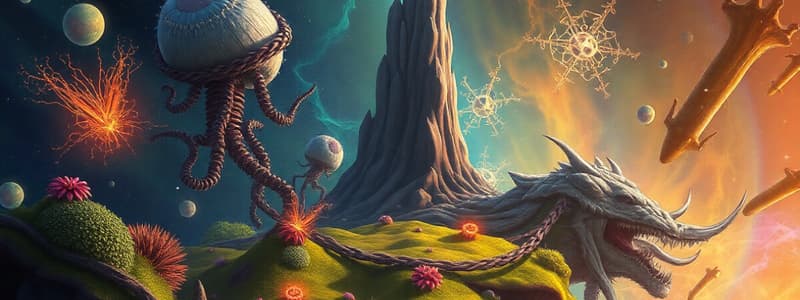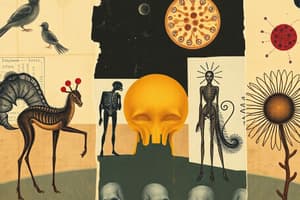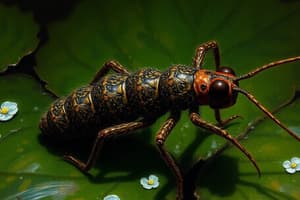Podcast
Questions and Answers
Which of the following is a characteristic shared by all animals?
Which of the following is a characteristic shared by all animals?
- They are unicellular.
- They reproduce asexually.
- They are autotrophs.
- They are heterotrophs. (correct)
What is the main difference between prokaryotic and eukaryotic cells?
What is the main difference between prokaryotic and eukaryotic cells?
- Eukaryotic cells have a nucleus, while prokaryotic cells do not. (correct)
- Prokaryotic cells have a nucleus, while eukaryotic cells do not.
- Eukaryotic cells have chloroplasts while prokaryotes do not.
- Eukaryotic cells are always multicellular.
How do fungi obtain nutrients?
How do fungi obtain nutrients?
- By secreting digestive enzymes onto food and absorbing the broken-down nutrients. (correct)
- Through photosynthesis like plants.
- By ingesting food like animals.
- By directly absorbing nutrients from the sun.
Which of the following kingdoms contains organisms that are both unicellular and multicellular?
Which of the following kingdoms contains organisms that are both unicellular and multicellular?
Which of the following organisms are not classified under any of the five kingdoms of life?
Which of the following organisms are not classified under any of the five kingdoms of life?
Which statement best describes a similarity between some protists and plants?
Which statement best describes a similarity between some protists and plants?
Which of these statements accurately describes bacteria??
Which of these statements accurately describes bacteria??
What is the primary role of hyphae in multicellular fungi?
What is the primary role of hyphae in multicellular fungi?
Flashcards
Eukaryotes
Eukaryotes
Organisms made up of many cells, with a nucleus containing their DNA.
Prokaryotes
Prokaryotes
Organisms with single-celled bodies, lacking a nucleus.
Heterotrophs
Heterotrophs
Organisms that obtain energy by consuming other organisms, like animals.
Autotrophs
Autotrophs
Signup and view all the flashcards
Saprotrophs
Saprotrophs
Signup and view all the flashcards
Protists
Protists
Signup and view all the flashcards
Mycelium
Mycelium
Signup and view all the flashcards
Bacteria
Bacteria
Signup and view all the flashcards
Study Notes
The Five Kingdoms of Life
- Almost all living organisms belong to one of the five kingdoms: animals, plants, fungi, protists, and bacteria.
- Viruses are not considered living organisms and therefore are not part of any kingdom.
- Animals, plants, fungi, and protists are all eukaryotes, meaning their cells have a nucleus that holds their DNA.
- Bacteria are prokaryotes, meaning their cells lack a nucleus and their DNA is not contained within a membrane.
- Viruses are much smaller than prokaryotic cells, and do not fit into the classification of eukaryotes or prokaryotes.
Animals
- There are an estimated 5 to 10 million species of animals on earth.
- All animals are multicellular, meaning they are made up of many cells.
- Animals are heterotrophs, meaning they get their energy from consuming other organisms.
- Most animals reproduce sexually.
Plants
- There are an estimated 300,000 species of plants on earth.
- Plants are multicellular.
- Plants are autotrophs, meaning they get their energy from the sun through photosynthesis.
Fungi
- Fungi can be multicellular or unicellular (single-celled).
- Unlike plants, fungi cannot photosynthesize and are heterotrophs.
- Fungi are saprotrophs, meaning they feed by secreting digestive enzymes onto food outside their body, breaking it down, and then absorbing the nutrients.
- Multicellular fungi have a body called a mycelium, which is made up of many thread-like structures called hyphae.
- Some fungi are pathogens, meaning they can cause disease in humans (e.g., athlete's foot).
Protists
- "Protists," "protista," "protoctists," and "protester" all refer to the same thing.
- Most protists are unicellular.
- Some protists have chloroplasts and can photosynthesize like plants (e.g., chlorella, euglena).
- Other protists are heterotrophs, similar to animals (e.g., amoeba).
- Some protists are pathogens and can cause disease in humans (e.g., plasmodium, which causes malaria).
Bacteria
- Bacteria are single-celled organisms found in almost every environment.
- While some bacteria can photosynthesize, they do not have chloroplasts.
- Most bacteria are heterotrophs, feeding on other organisms (living or dead).
- There are likely many more species of bacteria than all other kingdoms combined.
- While some bacteria can cause disease (e.g., salmonella), most are harmless or even beneficial (e.g., bacteria in our intestines help digest food).
Viruses
- Viruses are extremely small particles, much smaller than prokaryotes.
- Viruses are not considered living organisms as they lack the characteristics of living organisms.
- Viruses are made up of a protein coat surrounding genetic material (DNA or RNA).
- Viruses can only reproduce inside living cells, meaning they are parasites that depend on other organisms for replication.
- All viruses are considered pathogens, as they always cause harm to the host organism when they reproduce.
- Examples of viruses include: influenza virus, tobacco mosaic virus, HIV, and COVID-19.
Studying That Suits You
Use AI to generate personalized quizzes and flashcards to suit your learning preferences.




